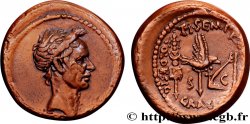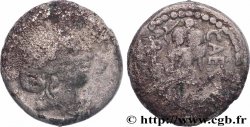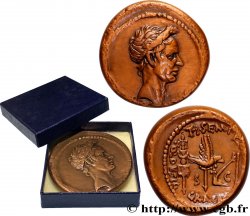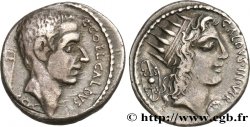v16_0367 - JULIO CAESAR Denier
MONNAIES 16 (2002)
Precio de inicio : 200.00 €
Valoración : 400.00 €
Precio realizado : 360.00 €
Número de ofertas : 29
Oferta más alta : 360.00 €
Precio de inicio : 200.00 €
Valoración : 400.00 €
Precio realizado : 360.00 €
Número de ofertas : 29
Oferta más alta : 360.00 €
Tipo : Denier
Fecha: 49 AC.
Nombre del taller / ciudad: Gaule ou Italie
Metal: plata
Milésimas de pureza : + 950 ‰
Diámetro: 16 mm
Eje de acuñación: 1 h.
Peso: 3,86 g.
Comentarios sobre el estado de conservación:
Exemplaire sur un flan étroit, un peu court au revers, mais de haut relief avec une jolie patine de médaillier
N° en los catálogos de referencia :
Pedigrí:
Cet exemplaire provient de la collection Terisse
Anverso
Titulatura del anverso: CAESAR À L'EXERGUE.
Descripción del anverso: Éléphant passant à droite ; à ses pieds, un serpent (ou carnyx, trompette gauloise).
Traducción del anverso: “Cæsar”, (César).
Reverso
Titulatura del reverso: ANÉPIGRAPHE.
Descripción del reverso: Instruments pontificaux : simpulum, aspersoir, hache à sacrifice, chapeau à sacrifice.
Comentario
Pour ce type, M. Crawford a relevé une estimation de 750 coins de droit et de 833 coins de revers, représentant une production qui pourrait avoisiner les deux à quatre millions de deniers. Pendant très longtemps on pensa que ce denier avait été frappé par César, pendant la Guerre des Gaules entre 58 et 52 avant J.-C, en Gaule même. En fait, il fut fabriqué au début des Guerres Civiles. Il a été imité servilement par les Trévires avec le bronze HIRTIVS (LT. 9235), fortement romanisé.
For this type, Mr. Crawford noted an estimate of 750 obverse dies and 833 reverse dies, representing a production that could be around two to four million denarii. For a very long time it was thought that this denarius had been struck by Caesar, during the Gallic Wars between 58 and 52 BC, in Gaul itself. In fact, it was made at the beginning of the Civil Wars. It was slavishly imitated by the Treveri with the bronze HIRTIVS (LT. 9235), heavily Romanized
For this type, Mr. Crawford noted an estimate of 750 obverse dies and 833 reverse dies, representing a production that could be around two to four million denarii. For a very long time it was thought that this denarius had been struck by Caesar, during the Gallic Wars between 58 and 52 BC, in Gaul itself. In fact, it was made at the beginning of the Civil Wars. It was slavishly imitated by the Treveri with the bronze HIRTIVS (LT. 9235), heavily Romanized








 Informar de un error
Informar de un error Imprimir la página
Imprimir la página Comparte mi selección
Comparte mi selección Haz una pregunta
Haz una pregunta Consignar / vender
Consignar / vender
 Descriptivo
Descriptivo















